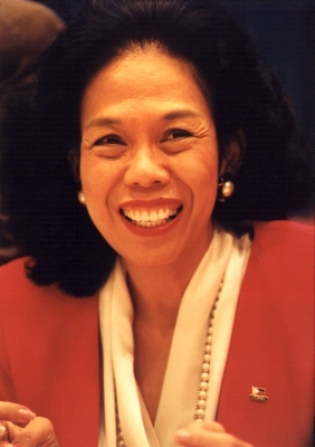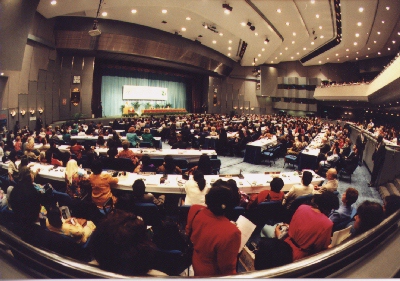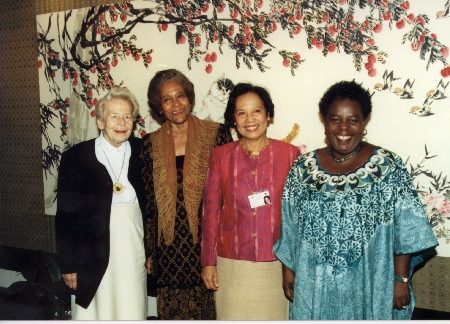U.N. Conferences on Women
After Beijing: Taking Action for Equality, Development and Peace
An extraordinary event in women's international organizing took place in Beijing, China, during September of 1995. Representatives of 189 governments and more than 2,100 non-governmental organizations (NGOs) convened to set forth a new agenda for women's empowerment and equality. The official conference and parallel NGO forum were the largest in U.N. history, attracting over 50,000 participants and observers.
Building on the work of previous conventions held in 1975, 1980 and 1985, during the United Nations Decade on Women, the fourth U.N. world conference on women produced the Beijing Platform for Action, which still stands as the most wide-reaching international commitment to women's rights. I.M.O.W. Global Council member Patricia Licuanan served as chairperson of the main committee of the Beijing conference, which drafted the platform for action. The following are excerpts from an exclusive interview with Dr. Licuanan.

What led up to the conference in Beijing?
In 1990, the U.N. Commission on the Status of Women (CSW) reviewed documents and progress from the Nairobi world conference in 1985. They concluded that equality in law had largely been achieved but not equality in fact.
That gave the commission the impetus to do something drastic, so they decided to plan a fourth world conference on women, one that was focused on priority areas with strategic objectives and actions. Planning began in 1990. I was the Philippine representative, then vice chairperson and eventually chairperson of CSW and the conference planning commission.
Selecting a title for the conference was very revealing. One early favorite was "Half the World, Half the Power," probably recommended by the Europeans. It got a lot of support initially, but then more sober heads prevailed, particularly from the developing world. They thought it was threatening and might turn off the men we want to support us. So the second suggestion was "Partnership for Equality, Development and Peace." Then we discovered there's no Chinese character for partnership between men and women outside of marriage. So we finally settled on "Action for Equality, Development and Peace."
In terms of the conference substance, they were the same issues raised during the U.N. decade for women (1975-1985). Many of those problems are still around.
How was the conference organized?
In Beijing, the official and NGO conferences were parallel events. My role was with the official meeting, but we encouraged governments to include NGOs in their delegations, we gave them access to most meetings, and whenever we could, we allowed NGO statements to be made on the floor.
It was not just governments vs. NGOs; governments represented a wide spectrum. You had very conservative NGOs and of course the Vatican, and then the European Union, the United States, Canada, Australia, which were all quite progressive.
Ultimately, the document that came out--like any U.N. consensus document--was a compromise. You negotiate things and eventually find something people can live with. There are tradeoffs. The major role I played at the conference was building consensus.
Can you provide a specific example?
For example, whenever we referred to human rights, particularly reproductive rights, the Islamic and Catholic groups wanted to insert a footnote about national and cultural norms.
Then sexual orientation came up. We thought it was harmless to mention in the anti-discrimination language along with race, gender, etc. But they wanted it removed. So we had a very long debate. Historically, that was the first time sexual orientation was discussed openly in a U.N. meeting!
At a certain point, I ended the debate and ruled that sexual orientation would be removed and that the footnote on cultural particularities would also be removed. The conservatives preferred not to have sexual orientation and were willing to give up the footnote. So, it's never a perfect solution but a compromise.
How do you think the Beijing Platform for Action has held up over time?
One of the platform's main accomplishments was with violence against women. There, we elevated something private to the level of public policy, and broadened the definition to include many things that were previously justified in the name of culture and tradition. We also strengthened the commitment to women's sexual and reproductive rights.
The concept of the "girl-child" was introduced for the first time, at the very last phase of the meetings. It was an add-on from Africa, but something that definitely needs more attention now.
We also identified women migrant workers as a specific group. The feminization of migration, particularly overseas employment, is very important today.
I think too that the attention to women's issues generated by the Beijing conference was truly historical and like nothing we'd ever seen before. The sheer numbers in both the official meeting and NGO forum were unprecedented.
The process of Beijing cannot be replicated today. We had national and regional activities. All the U.N. regions -- Asia, Africa, Europe, etc. -- had their own preparatory conference and parallel NGO forum. It was an extraordinary organizational feat and it paid off. Each regional meeting had input into the platform and that made it richer.
Will there be a fifth conference?
There's a lot of talk about a possible fifth world conference. It's been 15 years since Beijing. People are moving on to the next exciting thing and forgetting.
I believe that now is not the right time for another conference. Partly, it's the economics. Also, conceptualizing a conference focused on results and what we've learned from the past takes work.
The temper of the times has also changed. The 1990s were the high point of civil society participation in the U.N., with conferences in Rio, Cairo, Vienna, etc. There was a certain spirit and dynamism.
So many strong reactionary forces are in power now. Some major champions in Beijing now have governments that are not really interested in women's rights. Among them is the United States, not to mention religious fundamentalist groups.
Although I'd certainly like to keep the spirit of Beijing alive, there would be great danger in moving forward at least on the document side. There might be strong and possibly successful attempts to water down commitments made in the 1990s. So another conference would be risky.
How has women's organizing changed since Beijing?
We would not be working with many of the groups we work with now had it not been for the Beijing conference. We made so many friends and colleagues.
I've also spent several years watching women in delegations and non-governmental organizations at work. There has been a marked change in women's assertiveness and willingness to speak out. Their organizing, networking and communicating has evolved considerably.
It's a new strategy in a sense. We're doing things across boundaries a lot more. I'm interacting with women across the Asian-Pacific region all the time, probably as much as with people here at home. So there have been significant changes.
Has the U.N. made a real difference for women?
When push comes to shove, the U.N. is still a very important body. It gives women space to raise important issues, and it has been a big contributor to women's rights. Whatever its warts and imperfections, there's no substitute right now. But we have to push it more.
I'm very involved in U.N. reform and setting up a gender equality architecture within the U.N. Can we have, for instance, a women's agency with the stature and resources of UNICEF? The combined budget of the three main agencies for women, 65-70 million dollars, is pathetic compared to UNICEF, which has around 2 billion annually. Lobbying governments to speak up on our behalf is what's most frustrating about the U.N.
But whenever we start to feel cynical, there are surprises. For example, Kofi Annan appointed a high-level panel--with presidents of countries and so forth--to work on coherence and efficiency within the U.N. system. Women NGOs pushed for gender to be included in the discussion, and proposed a new structure headed by a high-ranking undersecretary general, with funding, a policy presence and on-the-ground presence.
We dialogued with the panel whenever they had outside consultations. They had one in Geneva, and we all rushed there to make our positions heard. I went through the motions and never thought the panel would support our proposed structure, but it did! When the job was done, there it was, exactly as we had asked. Now it's being discussed at the General Assembly. Who knows? Maybe it will materialize.
What issues should we focus on, going forward?
We're having a big global meeting here on gender, climate change and disaster prevention management. As usual, I'm looking back and trying to look forward at areas that have emerged or need more work.
Climate change is one. With the tsunami a few years ago we pushed for a U.N. resolution. People were quite blind to the fact that women were affected differently, that they needed certain types of support both materially and otherwise, and that they had an important role to play in rebuilding their lives and that of their communities.
Migration is another big area. Countries like the Philippines have sent so many people abroad to work that it has changed our national lifestyle. Now there are many types of migrants: people displaced because of natural disasters, economic refugees, and climate refugees.
Violence against women is still an issue. Much has been accomplished, certainly good laws and structures, but it's still a major problem.
I'm also interested in funding for gender and development. What does it mean to work towards the empowerment of women? Since Beijing, most countries have national machineries and commitments to women's issues but they are usually at a lower level, not well funded, and lacking expertise.
The U.N. mechanisms reflect these same shortcomings. That's why the gender equality architecture is important. If we have a good gender equality architecture within the U.N., that would help all these things significantly.
Women's groups just have to keep pushing and not give up.
Dr. Patricia Licuanan is president of Miriam College, an all-women's educational institution in Manila, Philippines.



